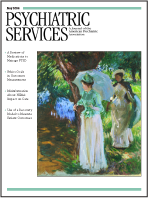Treatment Costs for Youths Receiving Multisystemic Therapy or Hospitalization After a Psychiatric Crisis
Abstract
OBJECTIVE: The authors conducted a cost analysis for multisystemic therapy, an evidence-based treatment that is used as an intensive community-based alternative to the hospitalization of youths presenting with psychiatric emergencies. METHODS: Data from a randomized clinical trial that compared multisystemic therapy with usual inpatient services followed by community aftercare were used to compare Medicaid costs and clinical outcomes during a four-month period postreferral and a 12-month follow-up period. Data were from 115 families receiving Medicaid (out of 156 families in the clinical trial). RESULTS: During the four months postreferral, multisystemic therapy was associated with an average net savings per youth treated of $1,617 compared with usual services. Costs during the 12-month follow-up period were similar between treatments. Multisystemic therapy demonstrated better short-term cost-effectiveness for each of the clinical outcomes (externalizing behavior, internalizing behavior, and global severity of symptoms) than did usual inpatient care and community aftercare. The two treatments demonstrated equivalent long-term cost-effectiveness. CONCLUSIONS: Among youths presenting with psychiatric emergencies, multisystemic therapy was associated with better outcomes at a lower cost during the initial postreferral period and with equivalent costs and outcomes during the 12-month follow-up period.



